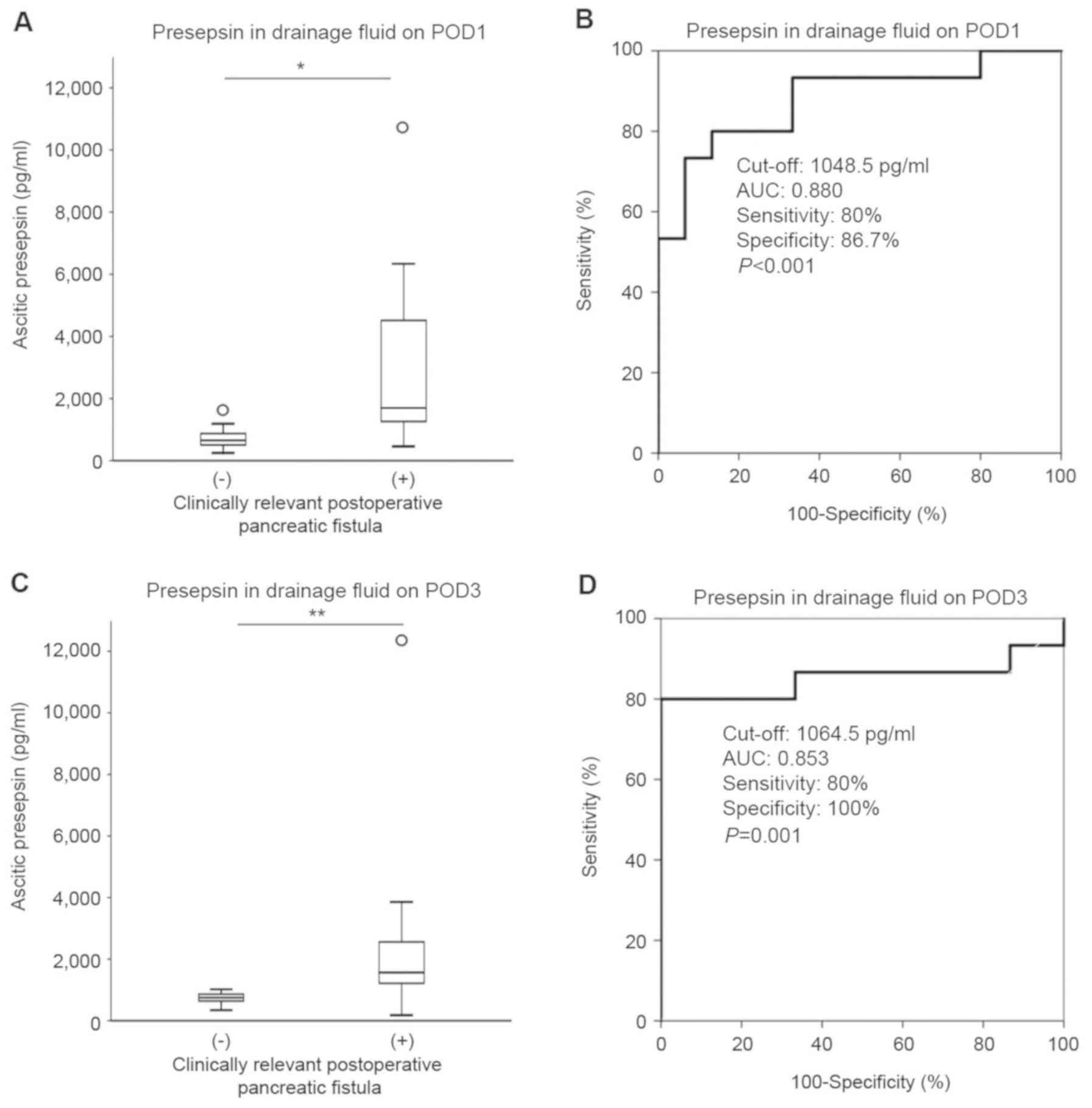|
1
|
Rosso E, Casnedi S, Pessaux P,
Oussoultzoglou E, Panaro F, Mahfud M, Jaeck D and Bachellier P: The
role of ‘fatty pancreas’ and of BMI in the occurrence of pancreatic
fistula after pancreaticoduodenectomy. J Gastrointest Surg.
13:1845–1851. 2009.
|
|
2
|
Kawai M, Kondo S, Yamaue H, Wada K, Sano
K, Motoi F, Unno M, Satoi S, Kwon AH, Hatori T, et al: Predictive
risk factors for clinically relevant pancreatic fistula analyzed in
1,239 patients with pancreaticoduodenectomy: Multicenter data
collection as a project study of pancreatic surgery by the Japanese
Society of Hepato-Biliary-Pancreatic Surgery. J Hepatobiliary
Pancreat Sci. 18:601–608. 2011.PubMed/NCBI View Article : Google Scholar
|
|
3
|
Kastenberg ZJ, Morton JM, Visser BC,
Norton JA and Poultsides GA: Hospital readmission after a
pancreaticoduodenectomy: An emerging quality metric? HPB (Oxford).
15:142–148. 2013.PubMed/NCBI View Article : Google Scholar
|
|
4
|
Kanda M, Fujii T, Suenaga M, Takami H,
Hattori M, Inokawa Y, Yamada S, Nakayama G, Sugimoto H, Koike M, et
al: Estimated pancreatic parenchymal remnant volume accurately
predicts clinically relevant pancreatic fistula after
pancreatoduodenectomy. Surgery. 156:601–610. 2014.PubMed/NCBI View Article : Google Scholar
|
|
5
|
Dalla Valle R, De Bellis M, Pedrazzi G,
Lamecchi L, Bianchi G, Pellegrino C and Iaria M: Can early serum
lipase measurement be routinely implemented to rule out clinically
significant pancreatic fistula after pancreaticoduodenectomy? Int J
Surg. 21 (Suppl 1):S50–S54. 2015.PubMed/NCBI View Article : Google Scholar
|
|
6
|
Partelli S, Pecorelli N, Muffatti F,
Belfiori G, Crippa S, Piazzai F, Castoldi R, Marmorale C, Balzano G
and Falconi M: Early postoperative prediction of clinically
relevant pancreatic fistula after pancreaticoduodenectomy:
Usefulness of C-reactive Protein. HPB (Oxford). 19:580–586.
2017.PubMed/NCBI View Article : Google Scholar
|
|
7
|
Okabayashi T, Maeda H, Nishimori I,
Sugimoto T, Ikeno T and Hanazaki K: Pancreatic fistula formation
after pancreaticooduodenectomy; for prevention of this deep
surgical site infection after pancreatic surgery.
Hepatogastroenterology. 56:519–523. 2009.PubMed/NCBI
|
|
8
|
Nagakawa Y, Matsudo T, Hijikata Y, Kikuchi
S, Bunso K, Suzuki Y, Kasuya K and Tsuchida A: Bacterial
contamination in ascitic fluid is associated with the development
of clinically relevant pancreatic fistula after
pancreatoduodenectomy. Pancreas. 42:701–706. 2013.PubMed/NCBI View Article : Google Scholar
|
|
9
|
Cloyd JM, Kastenberg ZJ, Visser BC,
Poultsides GA and Norton JA: Postoperative serum amylase predicts
pancreatic fistula formation following pancreaticoduodenectomy. J
Gastrointest Surg. 18:348–353. 2014.PubMed/NCBI View Article : Google Scholar
|
|
10
|
Palani Velu LK, Chandrabalan VV, Jabbar S,
McMillan DC, McKay CJ, Carter CR, Jamieson NB and Dickson EJ: Serum
amylase on the night of surgery predicts clinically significant
pancreatic fistula after pancreaticoduodenectomy. HPB (Oxford).
16:610–619. 2014.PubMed/NCBI View Article : Google Scholar
|
|
11
|
Yaegashi Y, Shirakawa K, Sato N, Suzuki Y,
Kojika M, Imai S, Takahashi G, Miyata M, Furusako S and Endo S:
Evaluation of a newly identified soluble CD14 subtype as a marker
for sepsis. J Infect Chemother. 11:234–238. 2005.PubMed/NCBI View Article : Google Scholar
|
|
12
|
Chenevier-Gobeaux C, Borderie D, Weiss N,
Mallet-Coste T and Claessens YE: Presepsin (sCD14-ST), an innate
immune response marker in sepsis. Clin Chim Acta. 450:97–103.
2015.PubMed/NCBI View Article : Google Scholar
|
|
13
|
Wright SD, Ramos RA, Tobias PS, Ulevitch
RJ and Mathison JC: CD14, a receptor for complexes of
lipopolysaccharide (LPS) and LPS binding protein. Science.
249:1431–1433. 1990.PubMed/NCBI View Article : Google Scholar
|
|
14
|
Yamashita K, Sasaki T, Itoh R, Kato D,
Hatano N, Soejima T, Ishii K, Takenawa T, Hiromatsu K and Yamashita
Y: Pancreatic fistulae secondary to trypsinogen activation by
Pseudomonas aeruginosa infection after pancreatoduodenectomy. J
Hepatobiliary Pancreat Sci. 22:454–462. 2015.PubMed/NCBI View
Article : Google Scholar
|
|
15
|
Fujii T, Sugimoto H, Yamada S, Kanda M,
Suenaga M, Takami H, Hattori M, Inokawa Y, Nomoto S, Fujiwara M and
Kodera Y: Modified Blumgart anastomosis for pancreaticojejunostomy:
Technical improvement in matched historical control study. J
Gastrointest Surg. 18:1108–1115. 2014.PubMed/NCBI View Article : Google Scholar
|
|
16
|
Bassi C, Marchegiani G, Dervenis C, Sarr
M, Abu Hilal M, Adham M, Allen P, Andersson R, Asbun HJ, Besselink
MG, et al: The 2016 update of the International Study Group (ISGPS)
definition and grading of postoperative pancreatic fistula: 11
years after. Surgery. 161:584–591. 2017.PubMed/NCBI View Article : Google Scholar
|
|
17
|
Del Chiaro M, Rangelova E, Ansorge C,
Blomberg J and Segersvard R: Impact of body mass index for patients
undergoing pancreaticoduodenectomy. World J Gastrointest
Pathophysiol. 4:37–42. 2013.PubMed/NCBI View Article : Google Scholar
|
|
18
|
Lee SE, Jang JY, Lim CS, Kang MJ, Kim SH,
Kim MA and Kim SW: Measurement of pancreatic fat by magnetic
resonance imaging: Predicting the occurrence of pancreatic fistula
after pancreatoduodenectomy. Ann Surg. 251:932–936. 2010.PubMed/NCBI View Article : Google Scholar
|
|
19
|
Facy O, Chalumeau C, Poussier M, Binquet
C, Rat P and Ortega-Deballon P: Diagnosis of postoperative
pancreatic fistula. Br J Surg. 99:1072–1075. 2012.PubMed/NCBI View
Article : Google Scholar
|
|
20
|
Whitcomb DC and Lowe ME: Human pancreatic
digestive enzymes. Dig Dis Sci. 52:1–17. 2007.PubMed/NCBI View Article : Google Scholar
|
|
21
|
Kawai M, Tani M, Terasawa H, Ina S, Hirono
S, Nishioka R, Miyazawa M, Uchiyama K and Yamaue H: Early removal
of prophylactic drains reduces the risk of intra-abdominal
infections in patients with pancreatic head resection: Prospective
study for 104 consecutive patients. Ann Surg. 244:1–7.
2006.PubMed/NCBI View Article : Google Scholar
|















